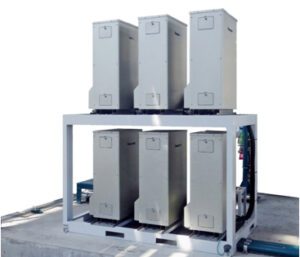Tokuyama Corp. (Tokyo) and Panasonic Corp. (Osaka, Japan) announced that they have started demonstration work on pure hydrogen fuel cell generators that use byproduct hydrogen generated in Tokuyama’s Tokuyama Factory in Shunan City, Yamaguchi Prefecture. The demonstration period is scheduled to end in March 2023.
Byproduct hydrogen is derived from the manufacturing process of caustic soda. With the acceleration of worldwide efforts to achieve the decarbonization of society, interest in hydrogen as a next-generation source of energy has been growing. The effective utilization of by-product hydrogen is of great importance from the perspectives of not only global warming prevention and energy security, but also the chemical industry’s contribution to society through the effective use of secondary products.

Demonstration equipment that will be used by Tokuyama and Panasonic (Source: Tokuyama)
For this demonstration, equipment was installed in the Tokuyama Factory. The equipment was configured into a system incorporating six pure hydrogen fuel cell generators, developed by Panasonic, into one unit. Hydrogen supply piping, thermal piping, and power output lines were connected and integrated with the unit, thereby achieving the synergistic operation of six pure hydrogen fuel cell generators as one system. This is the first demonstration in Japan1 of the integrated control of six pure hydrogen fuel cell generators.
Tokuyama provides a stable supply of byproduct hydrogen to pure hydrogen fuel cell generators. Such byproduct hydrogen is generated during the manufacturing of caustic soda through brine electrolysis by an ion-exchange membrane process. Electric power generated by the demonstration equipment is used in offices in the factory, and heat generated during power generation is recovered in the form of hot water. Tokuyama has been making efforts to effectively utilize byproduct hydrogen as well as build a contribution model for the local community through the use of hydrogen. This demonstration work is carried out as part of such efforts.
Additionally, Panasonic verifies and evaluates the integrated control of the system in addition to its operating performance when byproduct hydrogen is used. The on-off operation of the system’s six generator units, each of which can generate 700 W of electricity, can be individually controlled. Therefore, the system allows a flexible power output setting ranging from 700 W to 4.2 kW. This is with a view to future applications, where the system’s integrated control provides for major power demands. Moreover, even if one generator breaks down, the five remaining generators can continue to operate. This feature enables a generator-integrated system to continuously supply power if maintenance is sequentially performed on individual generators, thereby raising expectations for the improvement of system operational flexibility based on integrated control.